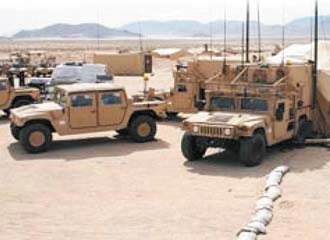Dialing Up the Bandwidth Battle Against IEDs
 |
When fully fielded, the Joint Counter Radio-Controlled Electronic Warfare (JCREW) system of systems will include manportable, vehicle-mounted and fixed-installation versions. The technology will give warfighters unprecedented counter-improvised explosive device (C-IED) capabilities. In the meantime, current C-IED systems are receiving upgrades through Band C, a technology that jams additional radio frequencies used by insurgents to detonate bombs. |
More than 70 percent of U.S. casualties on the battlefield result from attacks with improvised explosive devices, frequently controlled by a radio link. The weapons likely will remain a persistent threat worldwide for years to come, but work is ongoing to counter them. Already, upgrades to current capabilities are entering battle zones, and development is underway on a complex system of systems to advance defeat tactics. During the next few years, military members can expect improved protection that includes the jamming of more frequency bands and a networked toolset connecting dismounted soldiers, vehicles and fixed installations, all focused on bringing troops home safe and sound.
Technology dubbed Band C will upgrade the Counter Radio-Controlled Improvised Explosive Device (RCIED) Electronic Warfare (CREW) Vehicle Receiver Jammers (CVRJs). Compared to the older jammer, Band C inhibits more radio frequencies, covering a broader spectrum of current and evolving electronic warfare threats. Thousands of CVRJs are installed on Mine Resistant Ambush Protected and other legacy vehicles, and they themselves add capabilities into CREW systems.
Band C will be fielded as a separate box from CVRJs, but will take advantage of the resources already available in the jammers. It serves as a frequency up/down converter, operating in a new range, thus extending the number of frequencies users can cover. Specifics are sensitive information, protected to prevent enemies from knowing what U.S. forces can combat. People already in place in theater to perform the work will install the Band C systems, according to Capt. John Neagley, USN, Explosive Ordnance Disposal/CREW program manager, U.S. Naval Sea Systems Command.
That Navy command serves as the military’s executive agent for CVRJ and Band C, procuring the devices for all the military services that want them. Through the unit’s indefinite-delivery/indefinite-quantity contract, the Navy and Air Force have ordered approximately 1,200 of the Band C devices from ITT Corporation since April 2010. Most of the sailors who will employ the technology serve in units deployed on the ground such as explosive ordnance disposal and structure battalions. To date, the Marine Corps and the Army have not made purchases.
In addition to CVRJ technology, the Army employs Duke systems, another vehicle-mounted counter-RCIED technology that offers countermeasures to protect against a range of threats. For now, the soldiers have no plans to acquire Band C, but ITT expects the Marines to make an order when they finish testing the capabilities.
Band C is being fielded as a response to urgent requirements from the field. Though Capt. Neagley says that so far his office has received no specific feedback regarding Band C, personnel remain in constant contact with those deployed in theater to ensure that fielded solutions actually address problems. He explains that the IED threat has the potential to evolve very quickly, so the military constantly assesses the next evolutions of the threat on land and sea. The goal is to stay in front of the curve.
To that end, Band C fielding is part of a broader solution to enhance counter-RCIED efforts as the next generation of technology matures. The Naval Sea Systems Command also serves as the executive agent, and is contracting with ITT, for the Joint CREW (JCREW) 3.3, the third in the family of JCREW systems, which includes 3.1 and 3.2, the next manportable and vehicle-mounted systems, respectively. The vehicle-mounted configuration can fit land or riverine craft with slight differences in installation hardware. JCREW 3.3 also includes a fixed-installation version. Adding “joint” to the technology name denotes the multiservice umbrella covering the development.
Once the three initiatives are fielded, the system of systems will enable the networking of several jammers, addressing threats in a more efficient and strategic manner than current technologies. All types will work together to enhance information sharing and to prevent the detonation of IEDs.
Data collection and network function of JCREW will enhance coalition forces’ situational awareness and also will enable new reconnaissance, signals intelligence and electronic attack capabilities. It will feature both an open architecture and modular design. Capabilities include location prediction and disabling of explosives.
Configurations 3.1 through 3.3 will leverage a common technology license and common hardware to the maximum extent possible. Core technologies for each of them will be the same with peripheral differences; variants will involve necessary unique components such as higher power requirements for fixed-site systems.
Both CVRJ and the JCREW system of systems are designed to perform similar counter-RCIED tasks, but the latter will have additional bandwidth and will cover more frequencies, a response to commercial technologies’ use of increased parts of the frequency spectrum.
Paul Mueller, vice president and general manager of ITT’s Force Protection Systems business, explains that when the entire JCREW system fields, troops can collect information about their radio frequency environment, perform onboard processing and share information with commanders at other locations without stopping current IED missions. Commanders will be able to create a common operating picture based on the networking among systems components. Data logs can be sent to analysis centers, and near-real-time mission analysis will help troops better understand the weapons used against them.
Version 3.3 currently is in its engineering development model phase and will progress to low-rate initial production in the government’s fiscal year 2012 and testing in the 2013 time frame. Front deployment could take place sometime in 2013 or 2014. Before any of that occurs, Mueller anticipates a major production contract for Band C in the second quarter of this calendar year.
Developers are aware of the military’s previous investment in Duke and CVRJ systems and reductions in defense budgets. Designs seek to recapitalize on existing systems, and Mueller expects less than a one-to-one ratio of replacement of JCREWs to the other two systems. As resources become more limited due to shrinking budgets, system builders must become even more effective in defeating the threat to bring people home safely.
In line with what the military wants from its next-generation counter-RCIED technology, Mueller says developers are focusing not on threats in a particular area but on the art of the feasible. “We are trying to make sure what we field is forward facing prior to our adversary using these devices as a trigger,” he explains. “The sense of urgency is always to stay out in front the art of the possible.” Mueller continues that the primary purpose of JCREW 3.3 goes to the next level of defeat through its connections capabilities.
The possible scenarios Mueller mentions include combat in areas of the world far removed from desert environments. Band C and JCREW are ready for the challenge. He believes that the Marine Corps’ decision to move ahead with evaluating Band C and the Army’s choice to hold off reflects the differences in thinking between the services. The Marines are an expeditionary force—a viewpoint emphasized by leadership that is promoting certain programs, such as the experimental Expeditionary Forward Operating Base, to ensure the Corps remains agile—and are planning for the eventuality of deploying anywhere on Earth. The CVRJs and their Band C upgrades employ flexible architecture that enables users to adapt them for different needs and yet remain effective.
Mueller explains that although JCREW deployment will provide more and new capabilities, Band C is not simply a place-holder update until the new system deploys. “It’s not a Band-Aid, if you will,” he says. With the addition, the CVRJ will become more capable in dealing with current and anticipated threats. “CVRJ and Band C are the front-line systems,” Mueller states.
Capt. Neagley says that to ensure that warfighters have what they need to combat expanding threats he thinks “it’s important that we stay vigilant, that we stay focused on what we do and give warfighters the best equipment possible against the threats they’re facing. That’s our focus every day.”
WEB RESOURCES
U.S. Naval Sea Systems Command: www.navsea.navy.mil
ITT Force Protection Systems: http://fps.es.itt.com




Comments